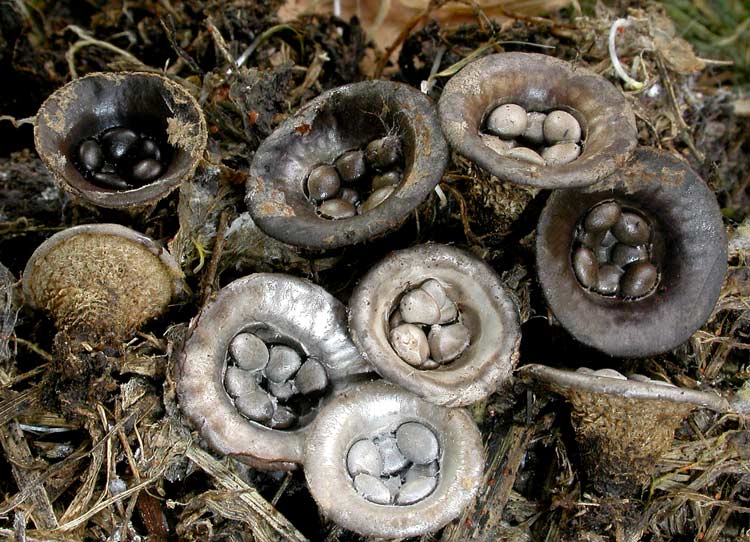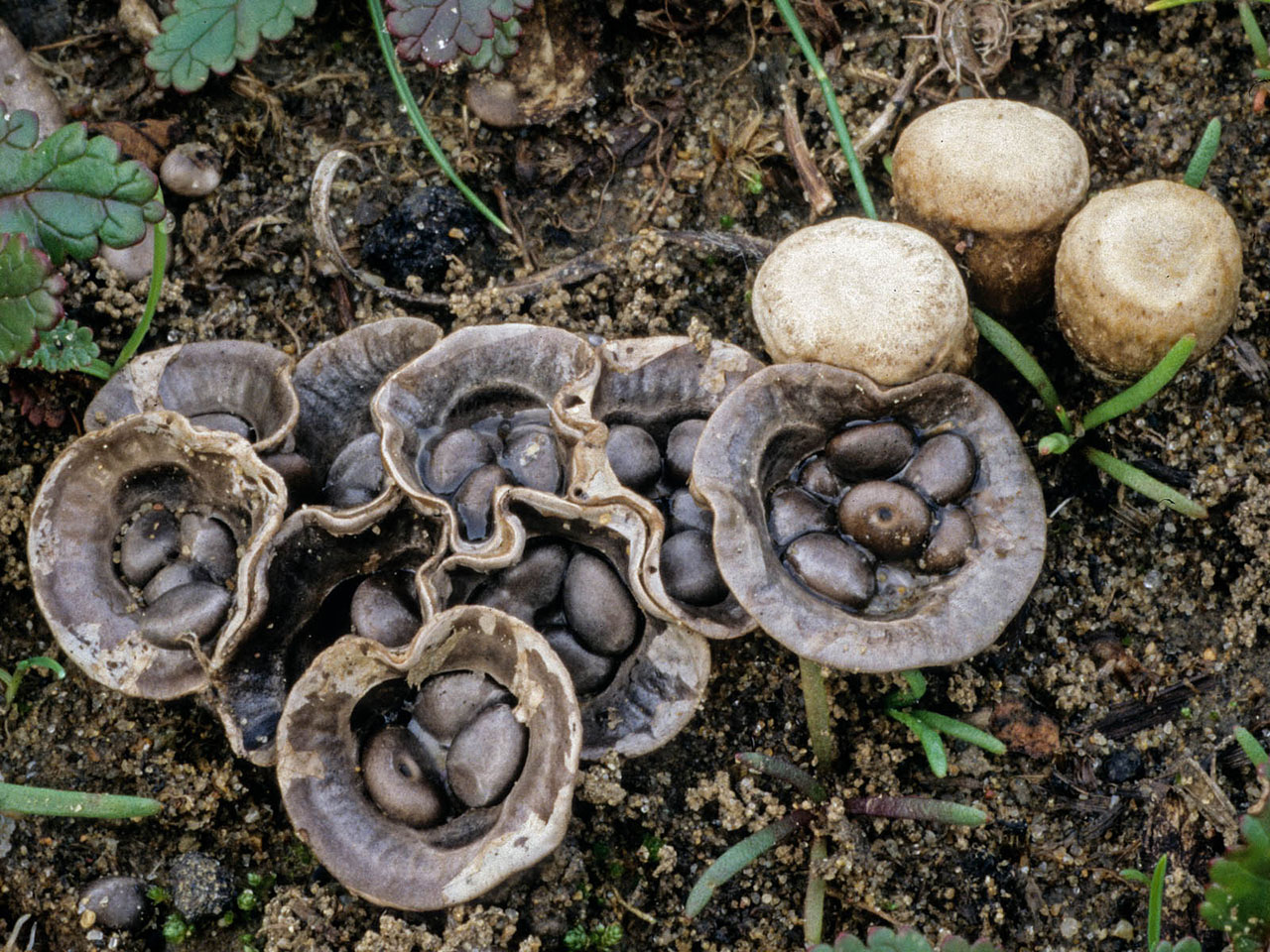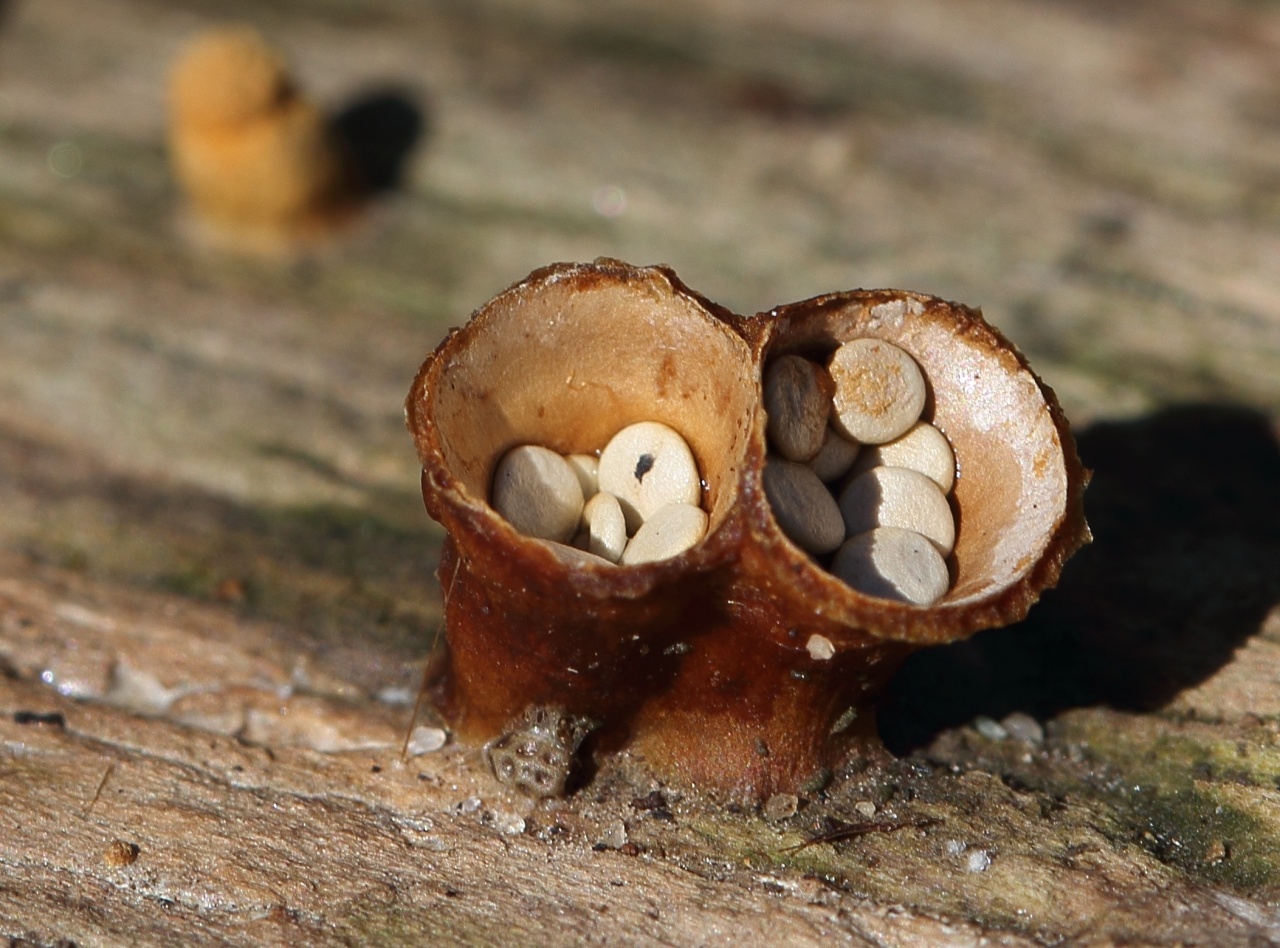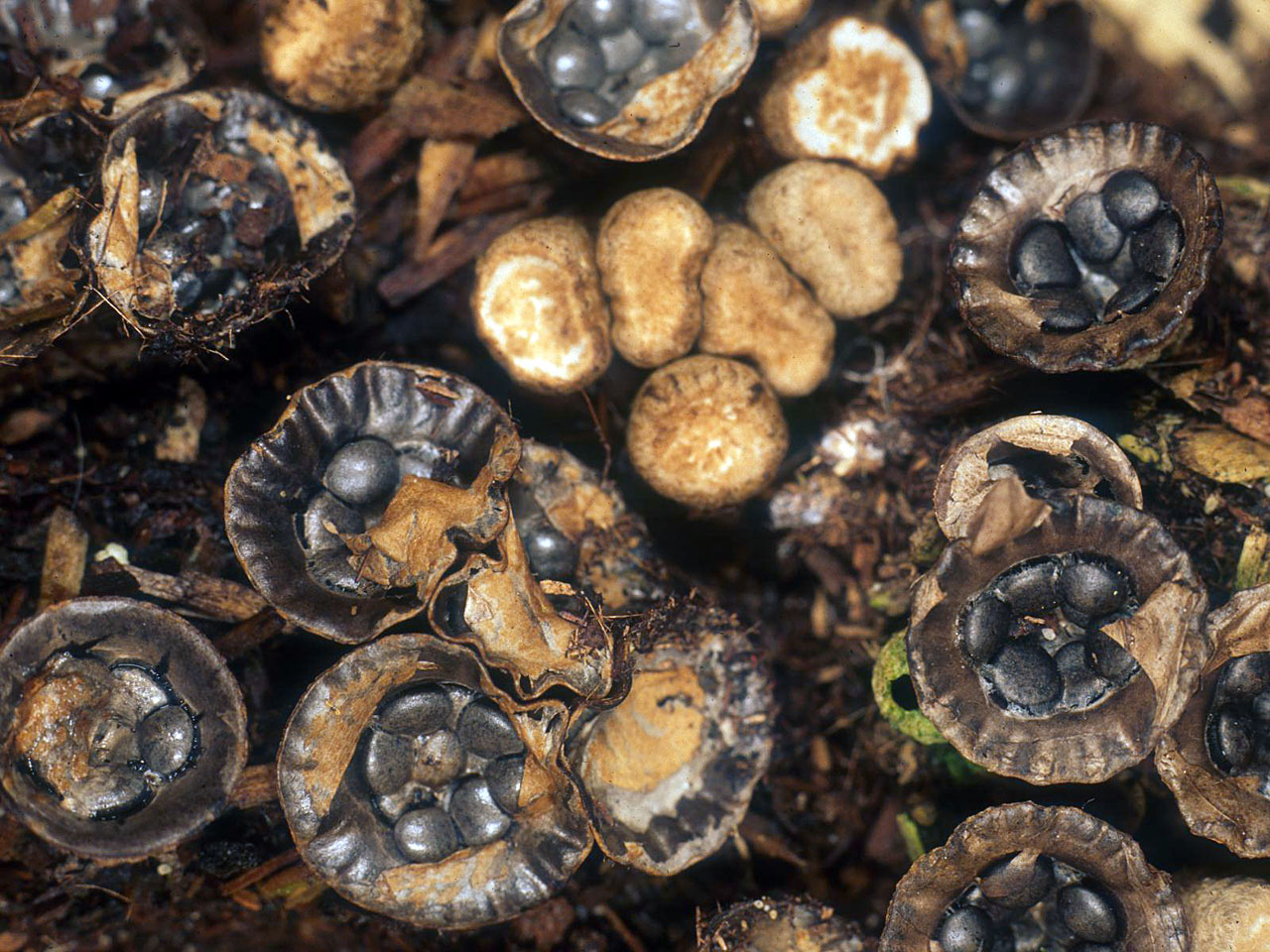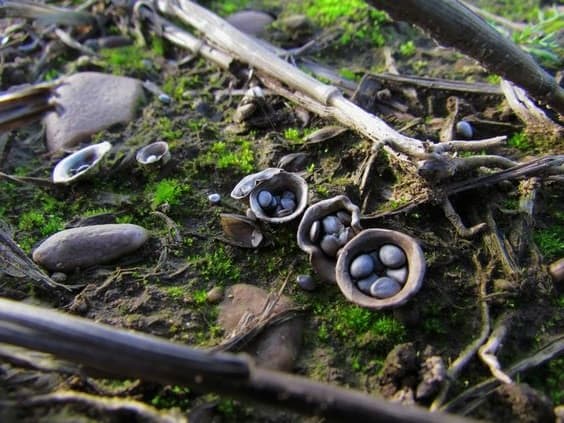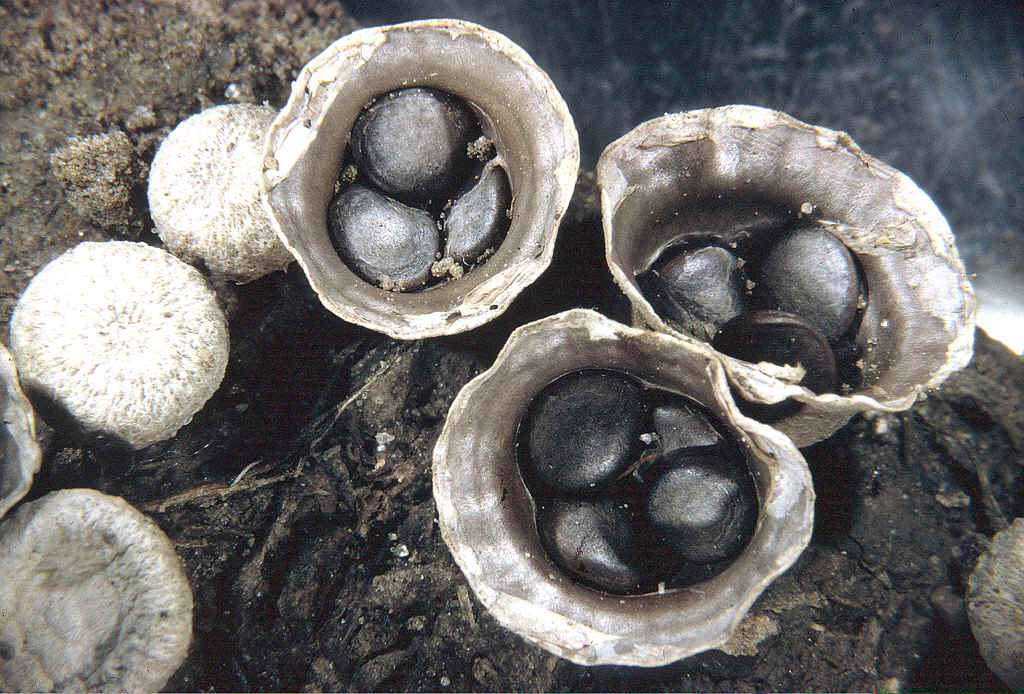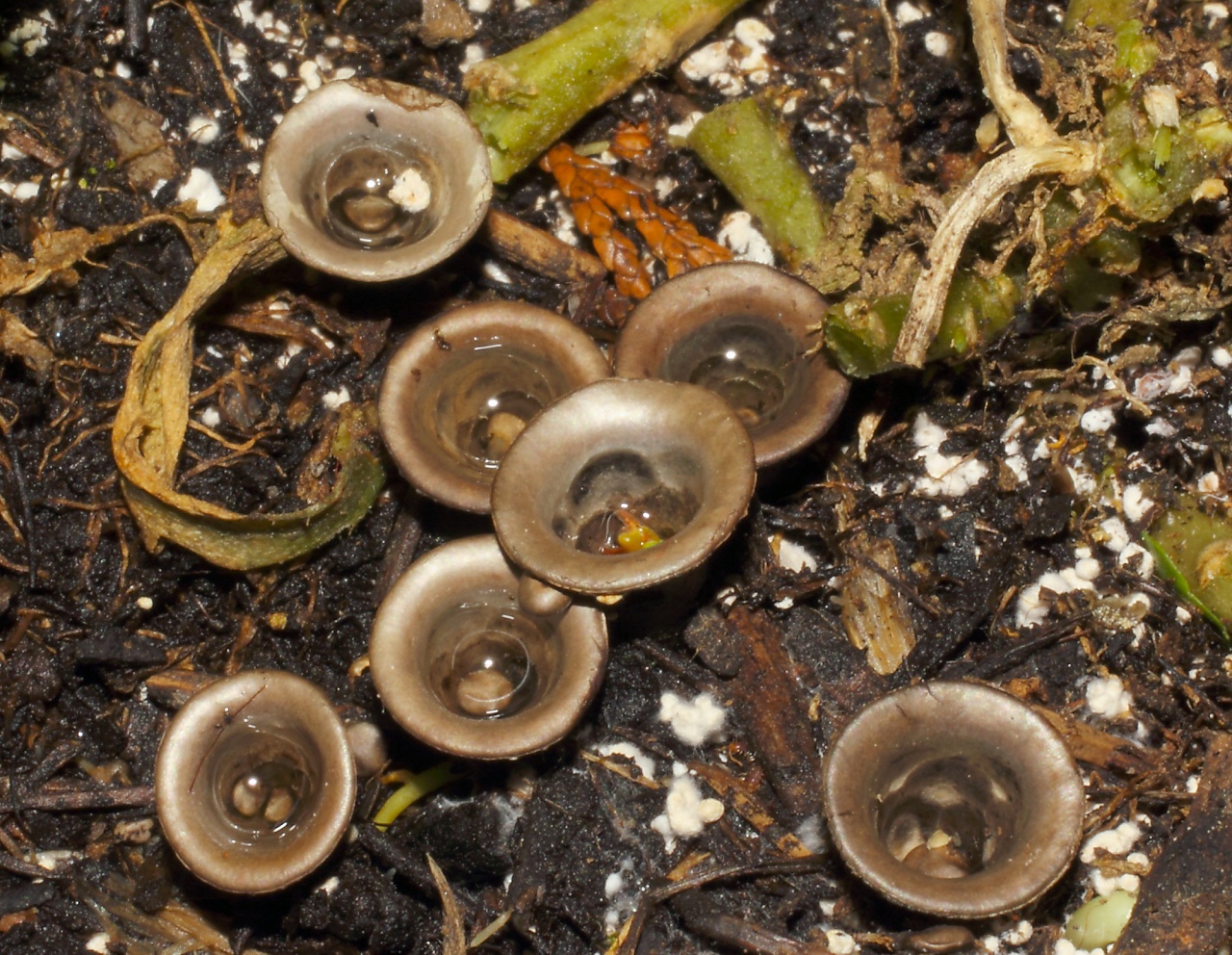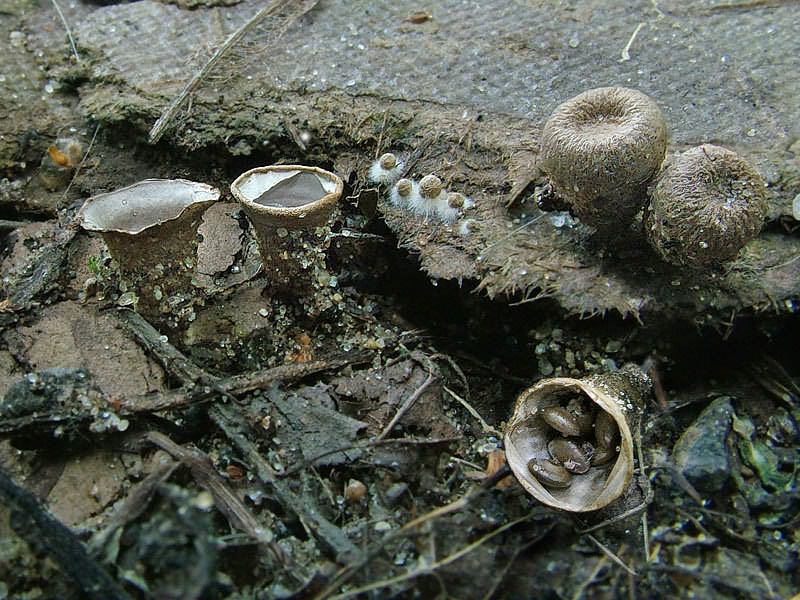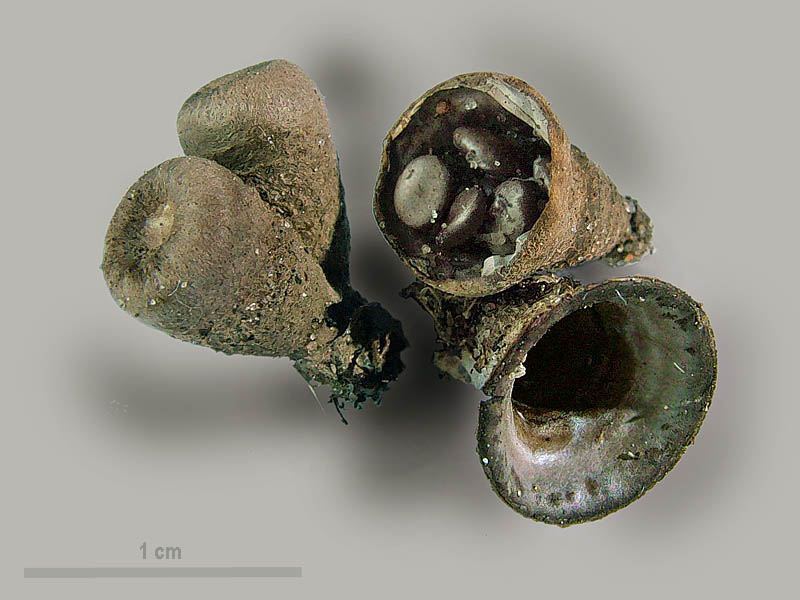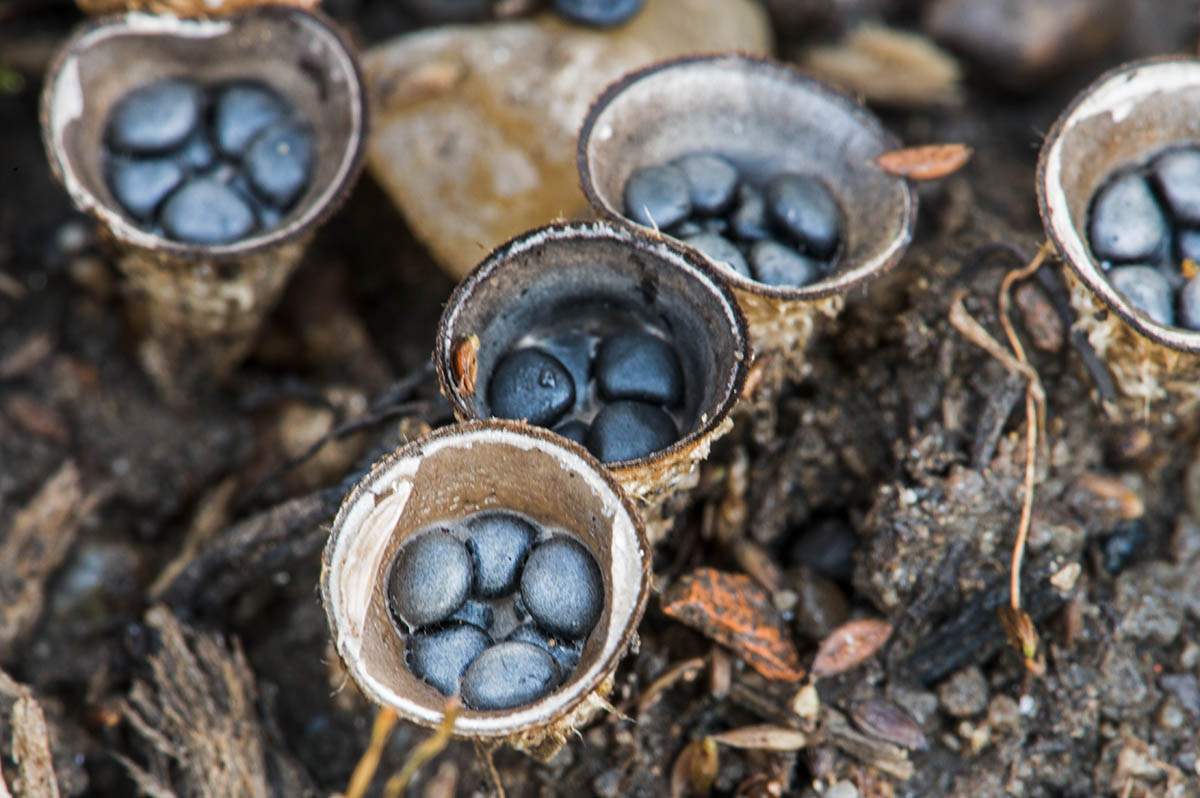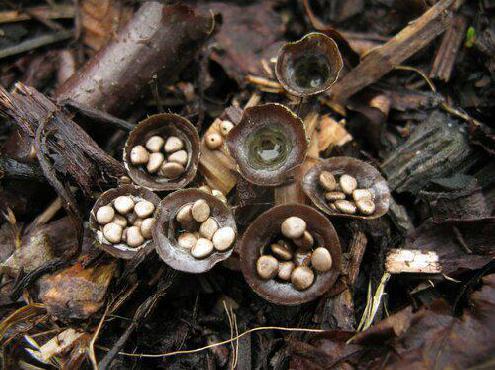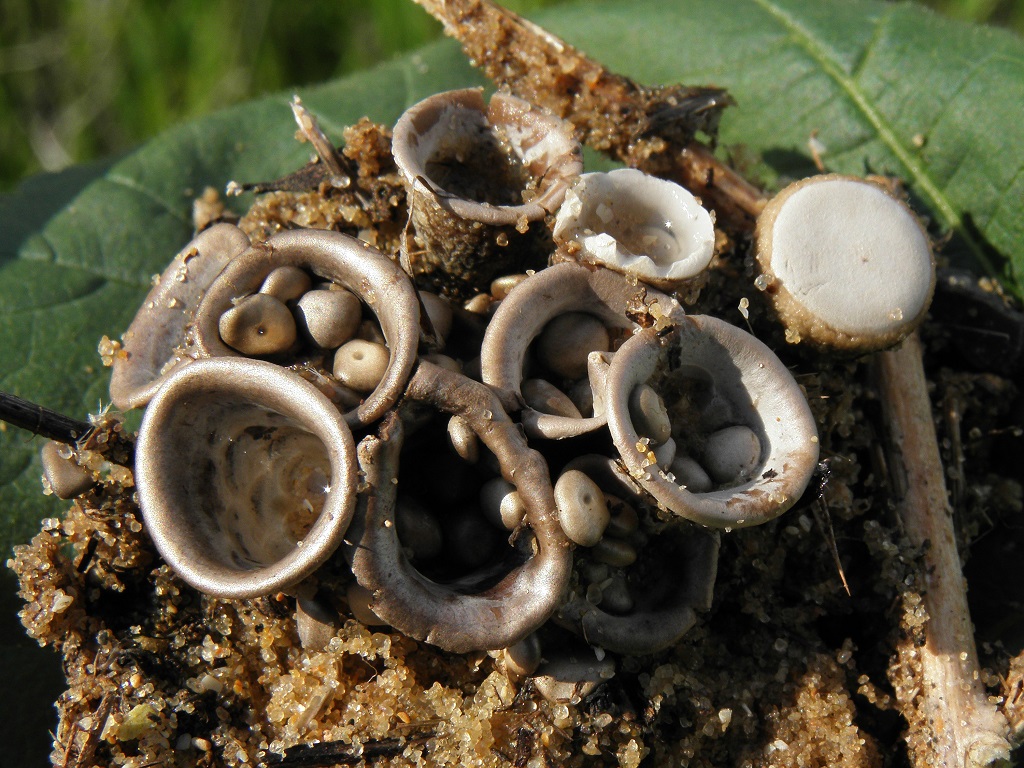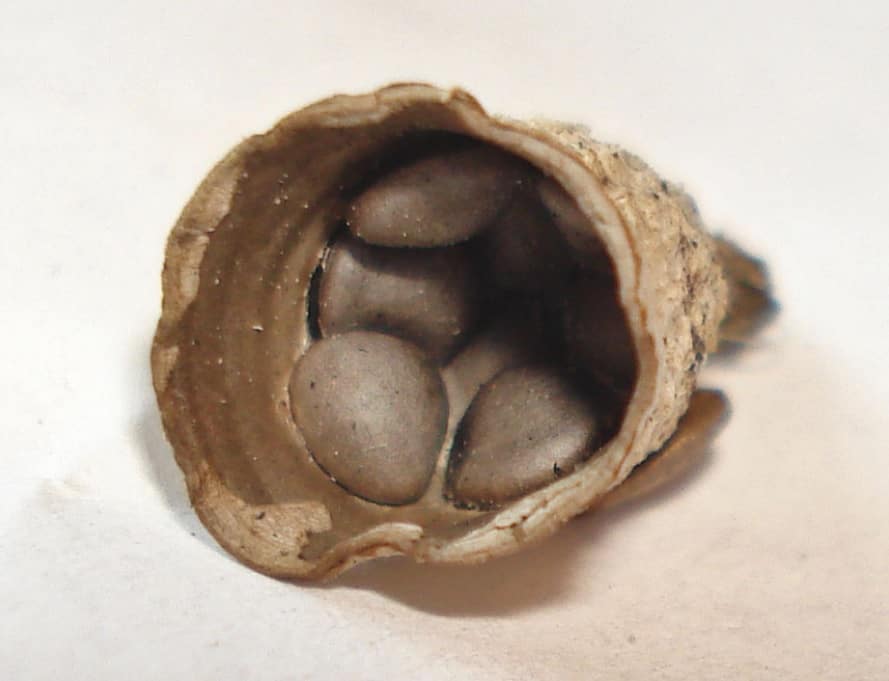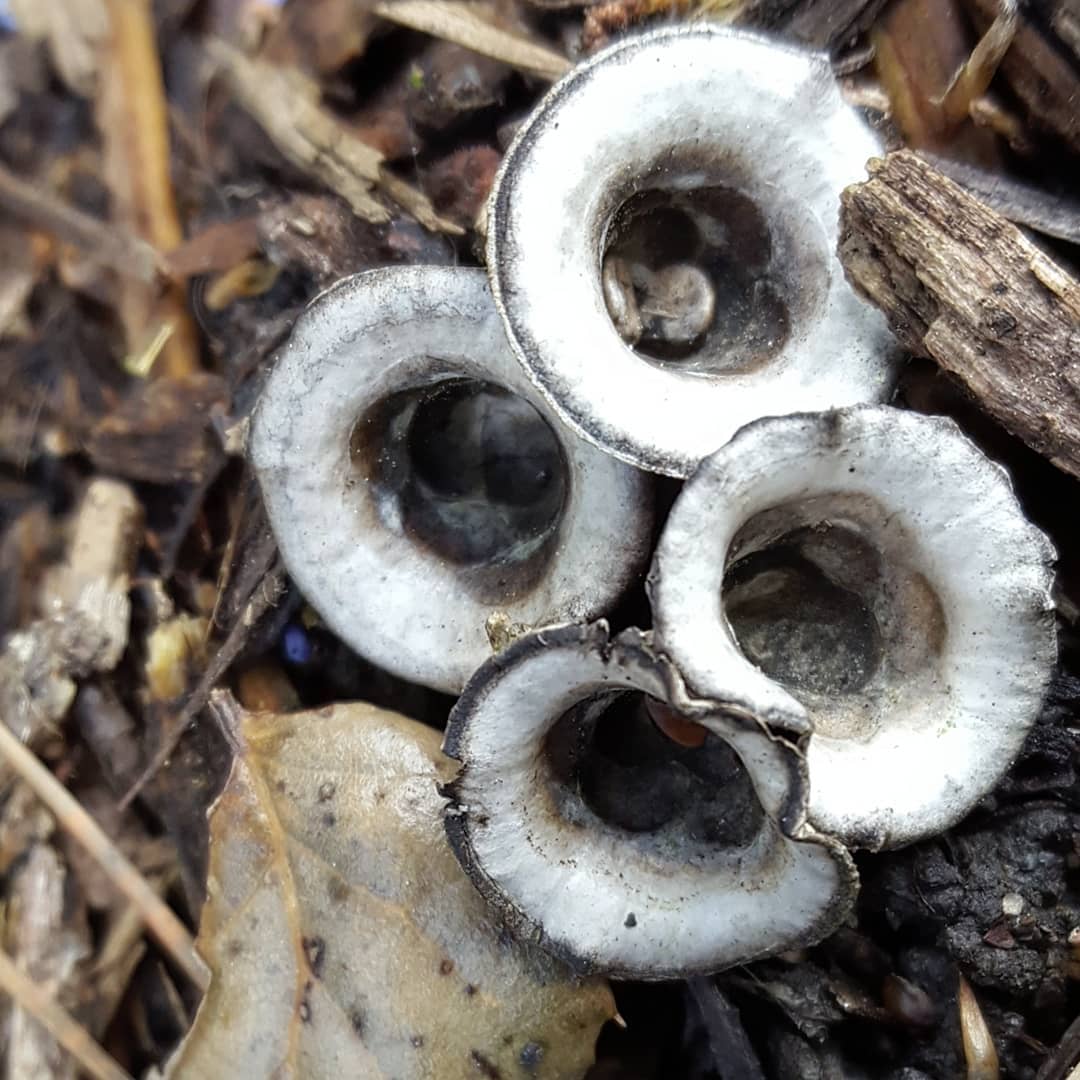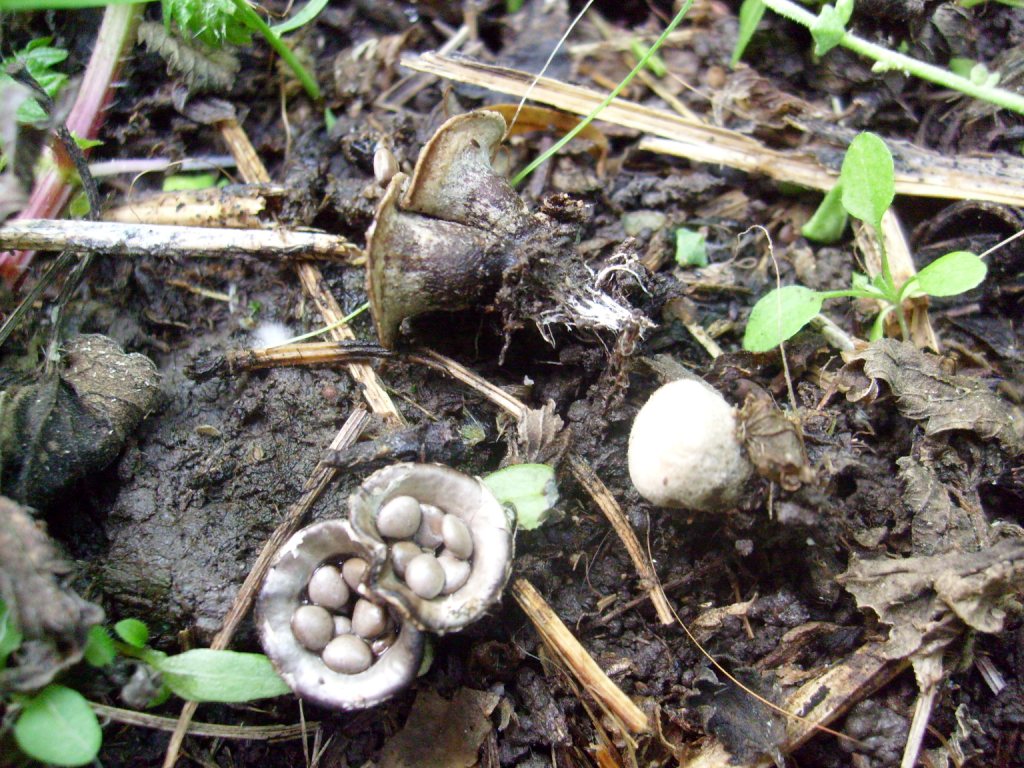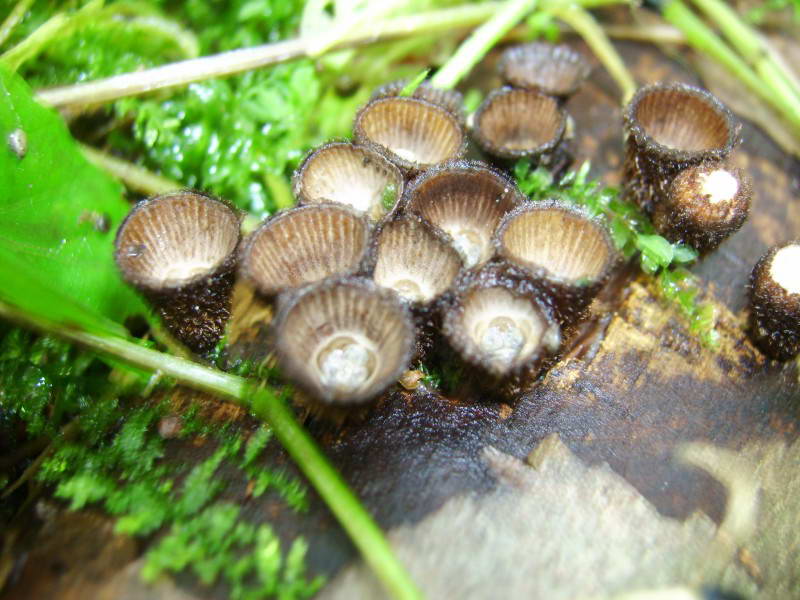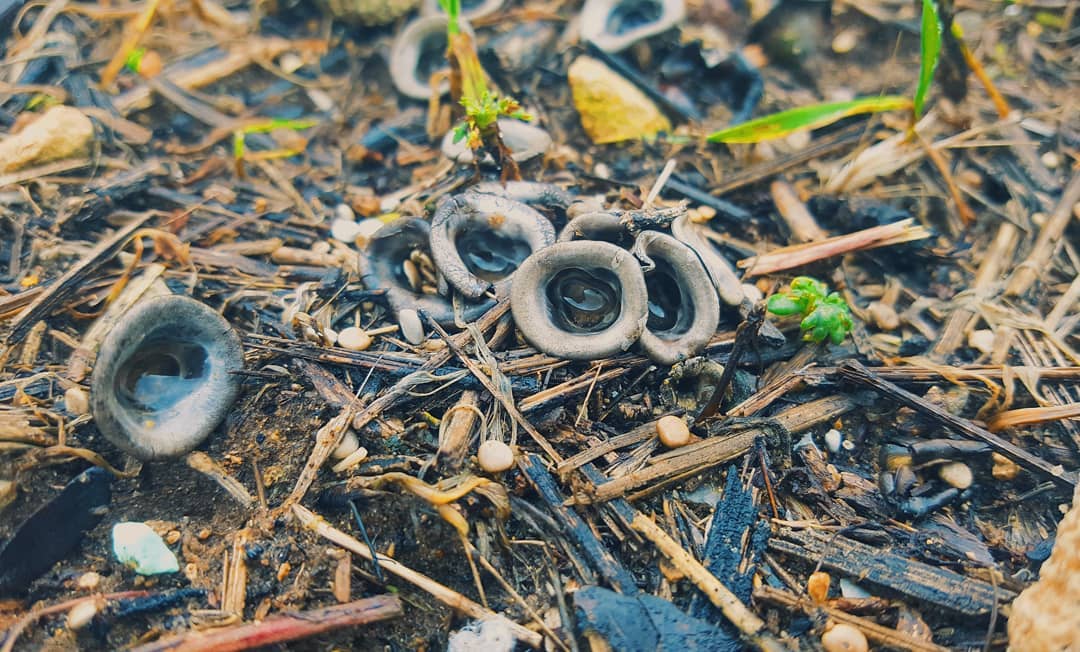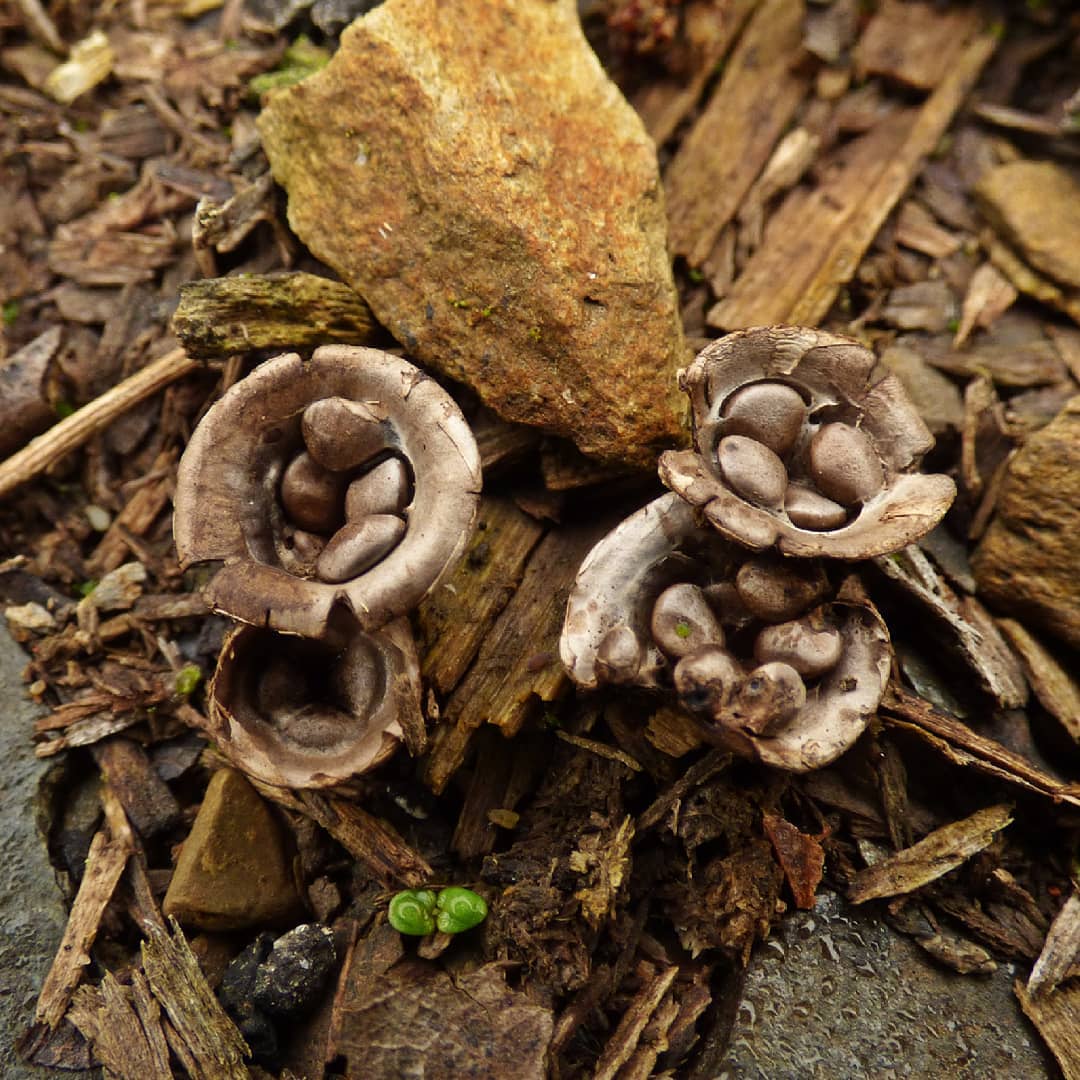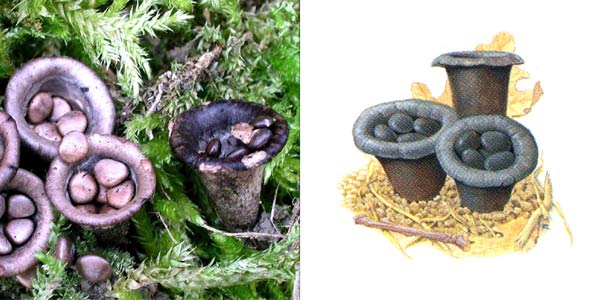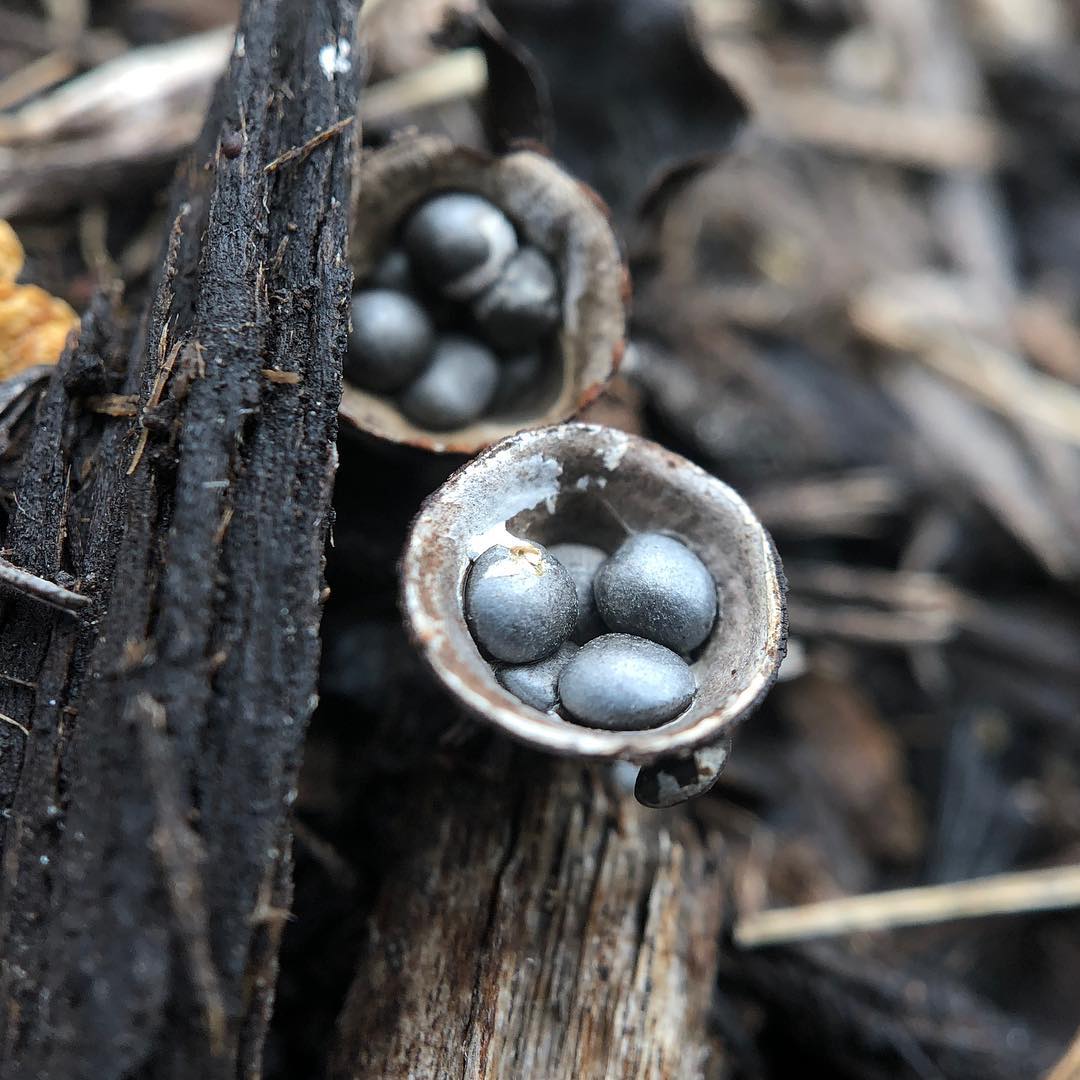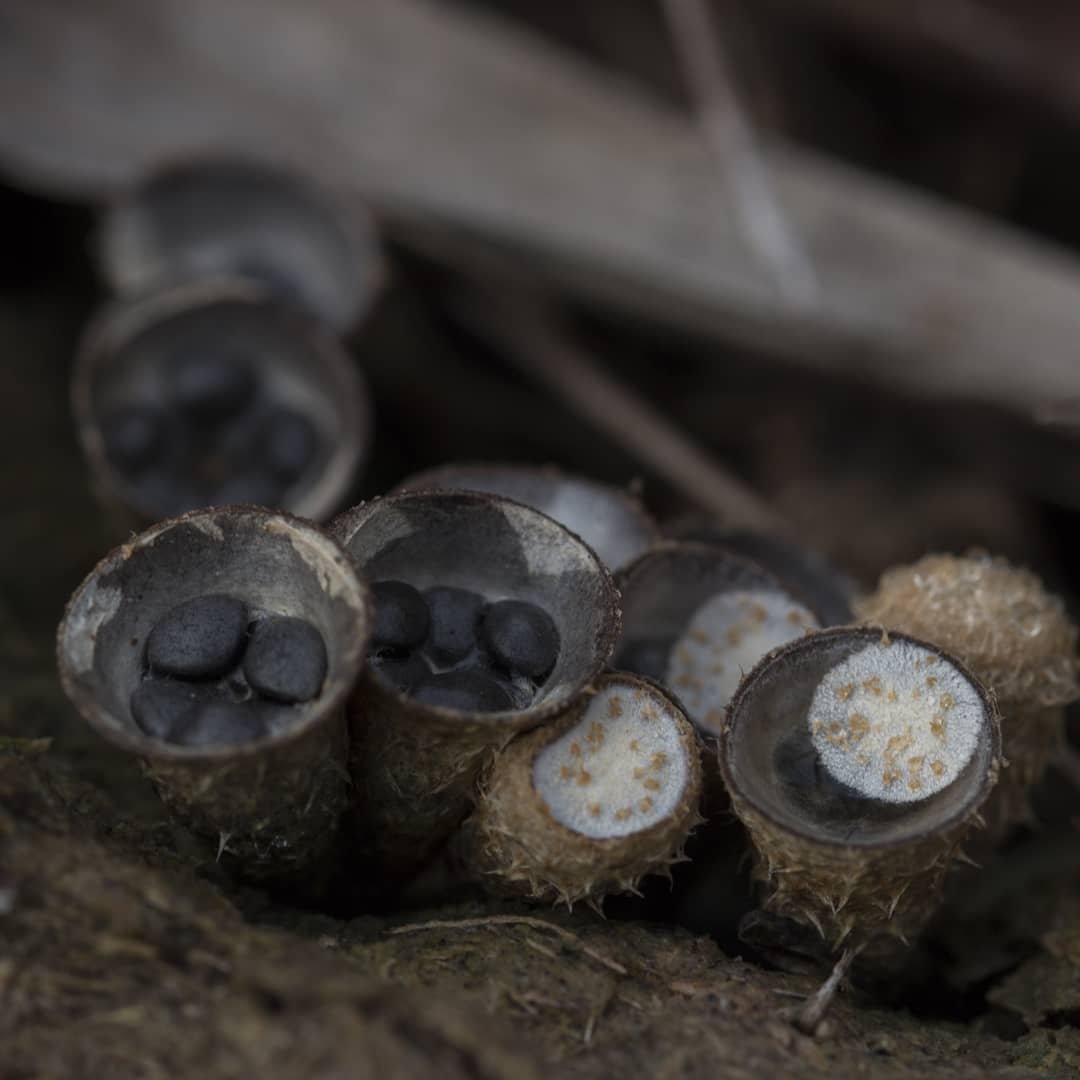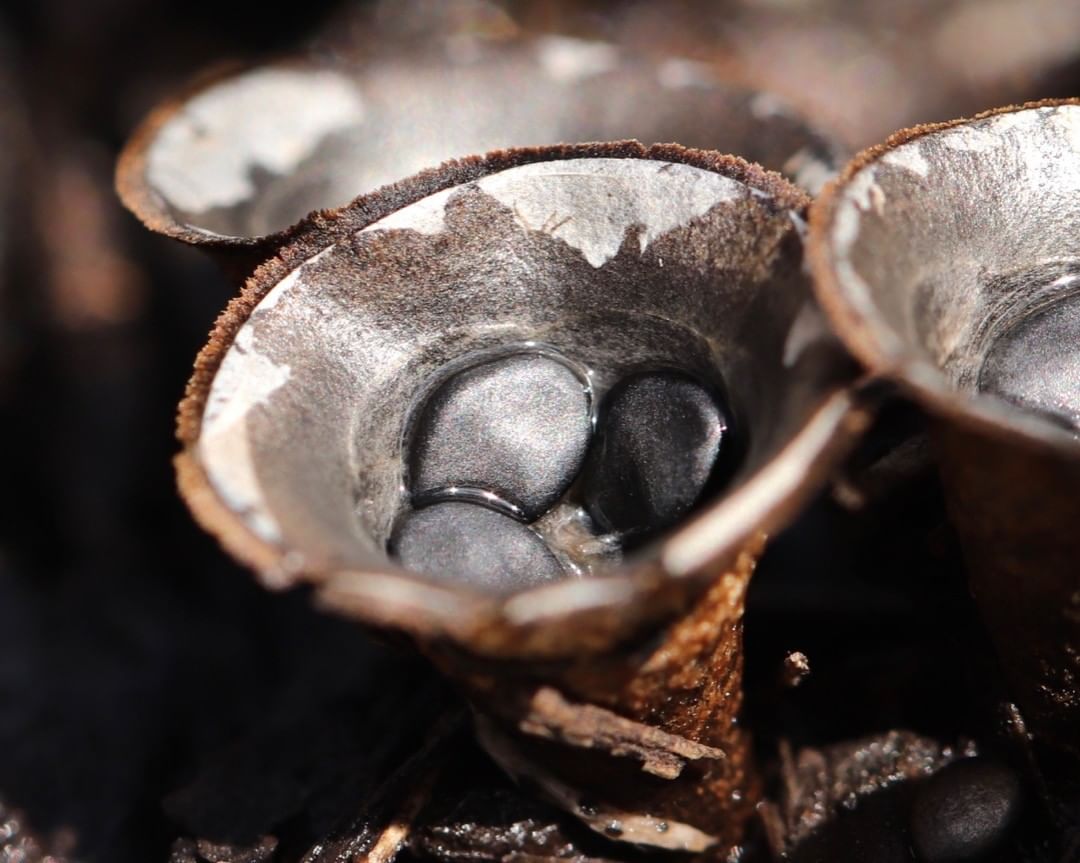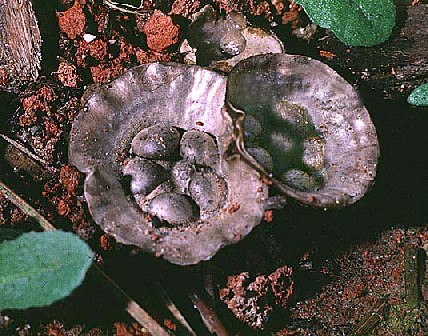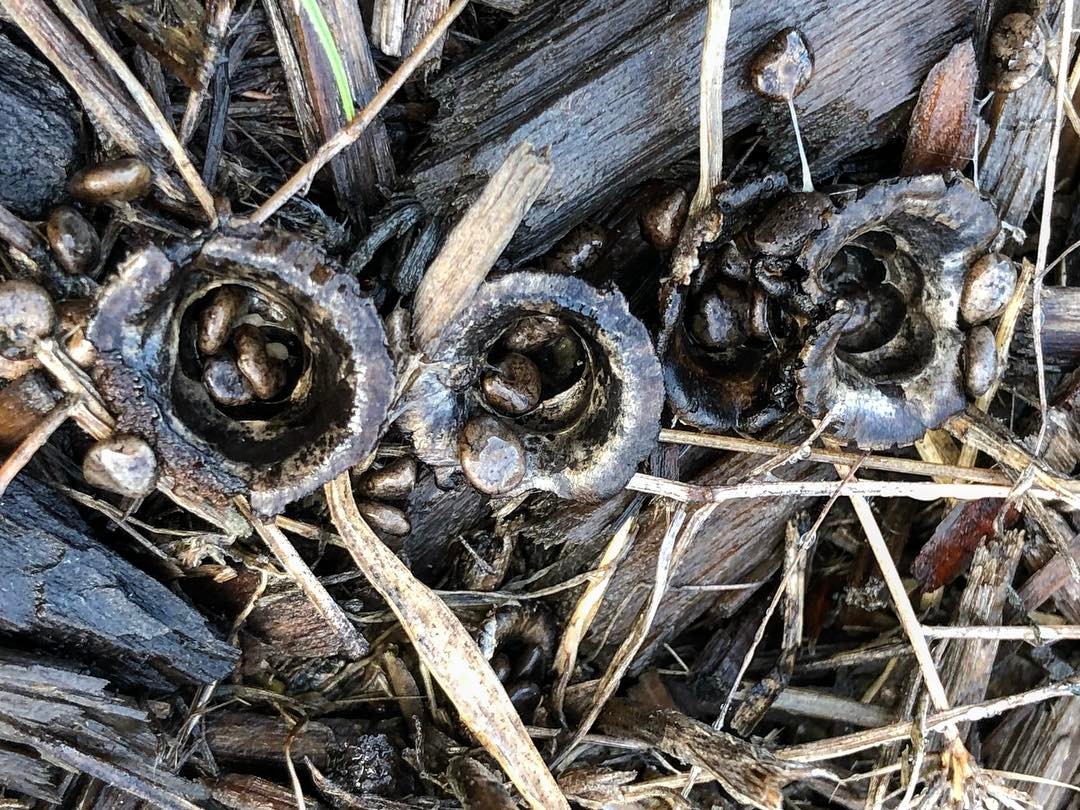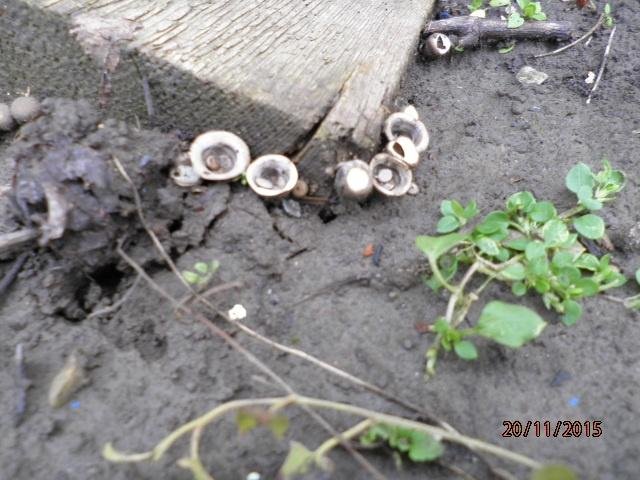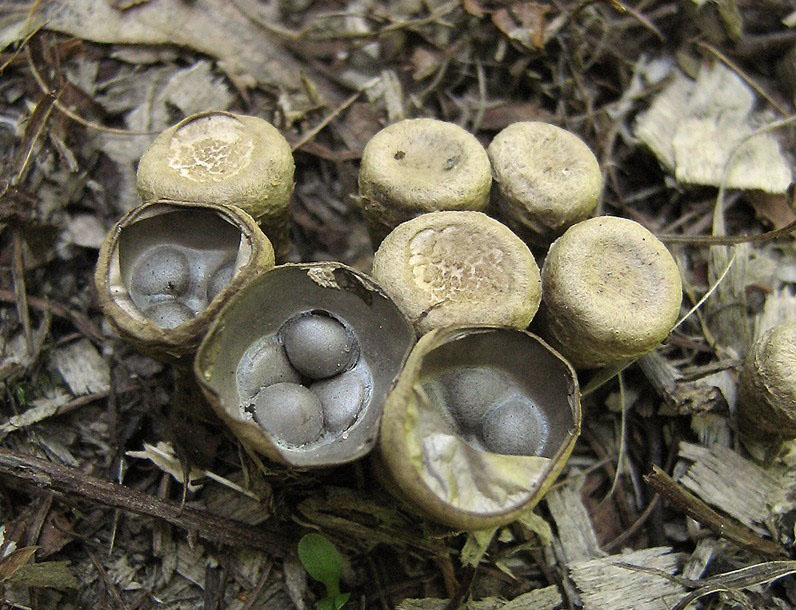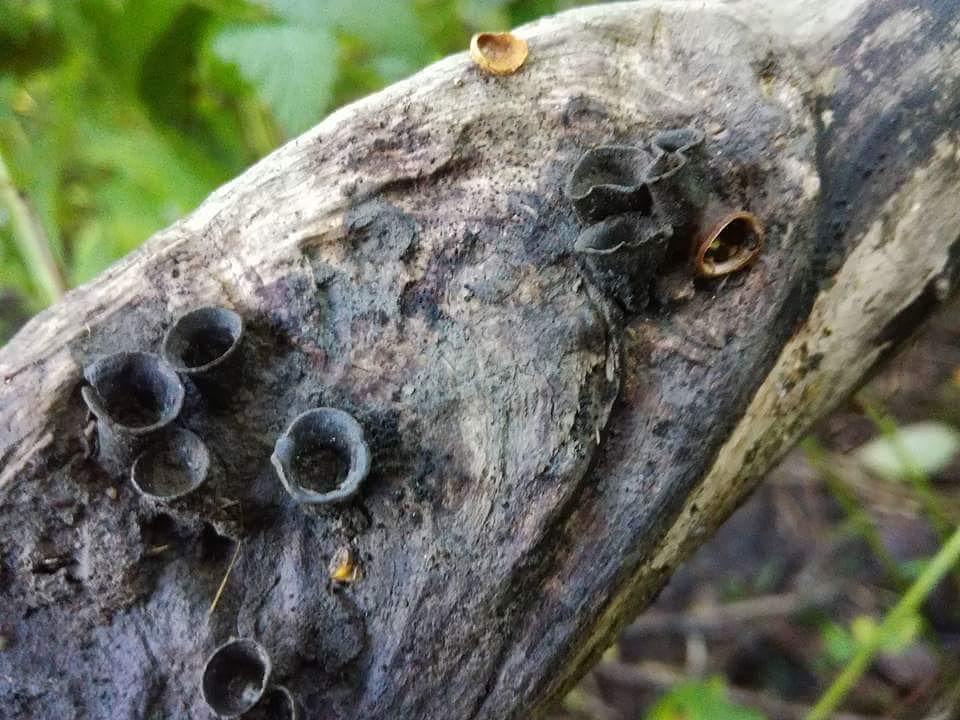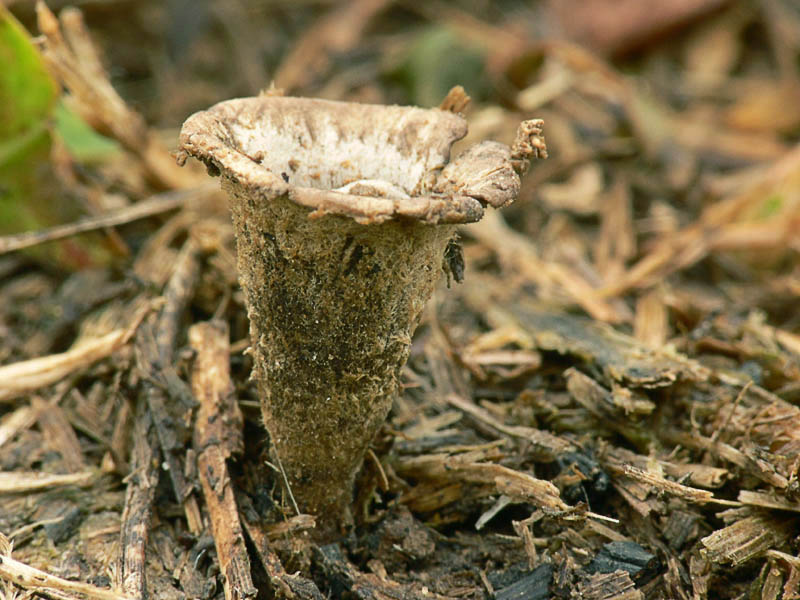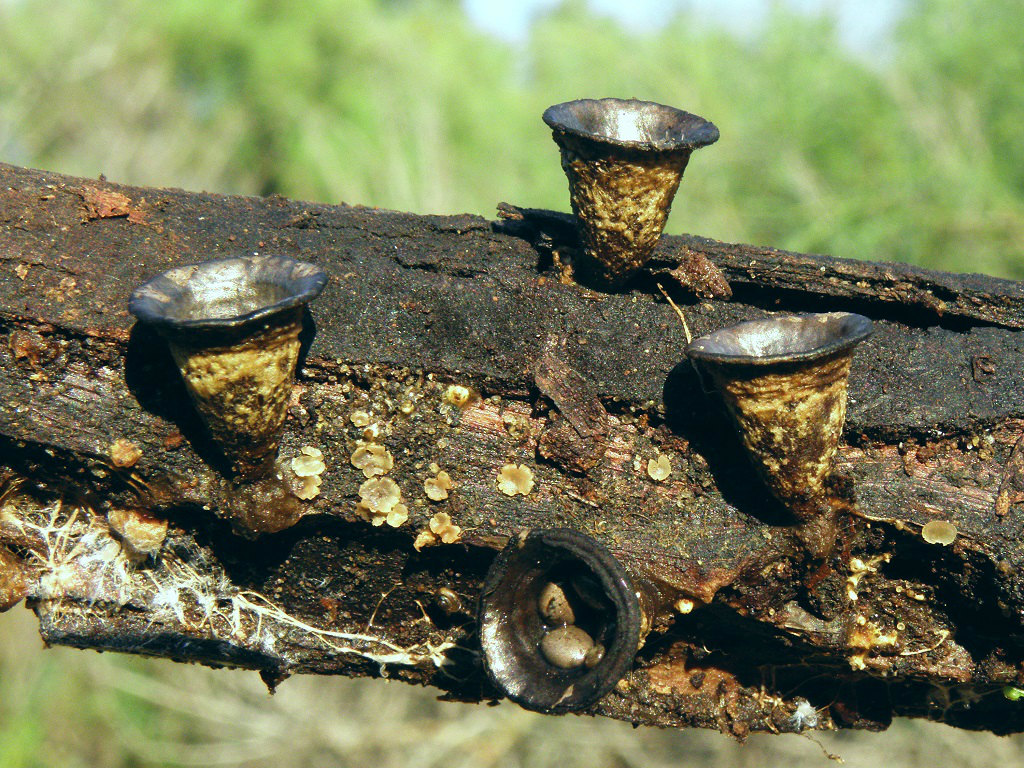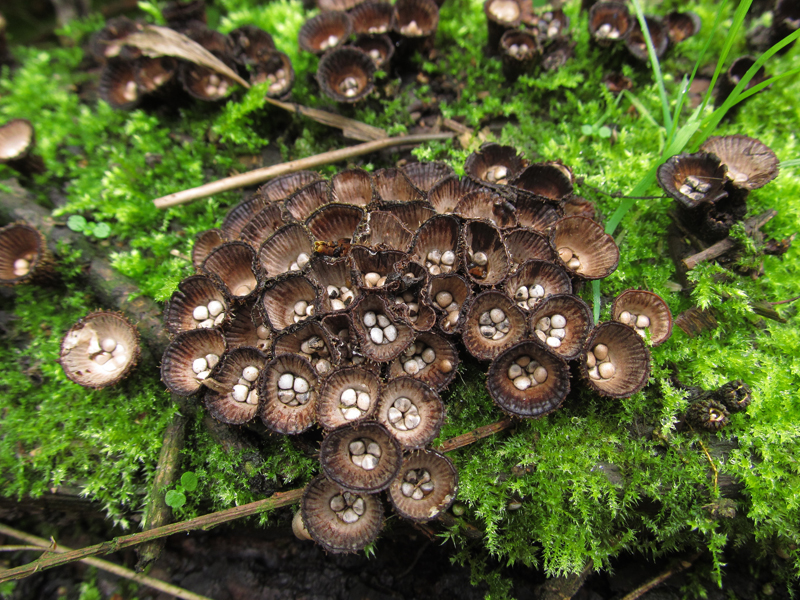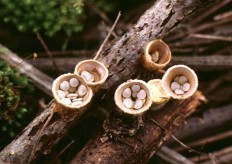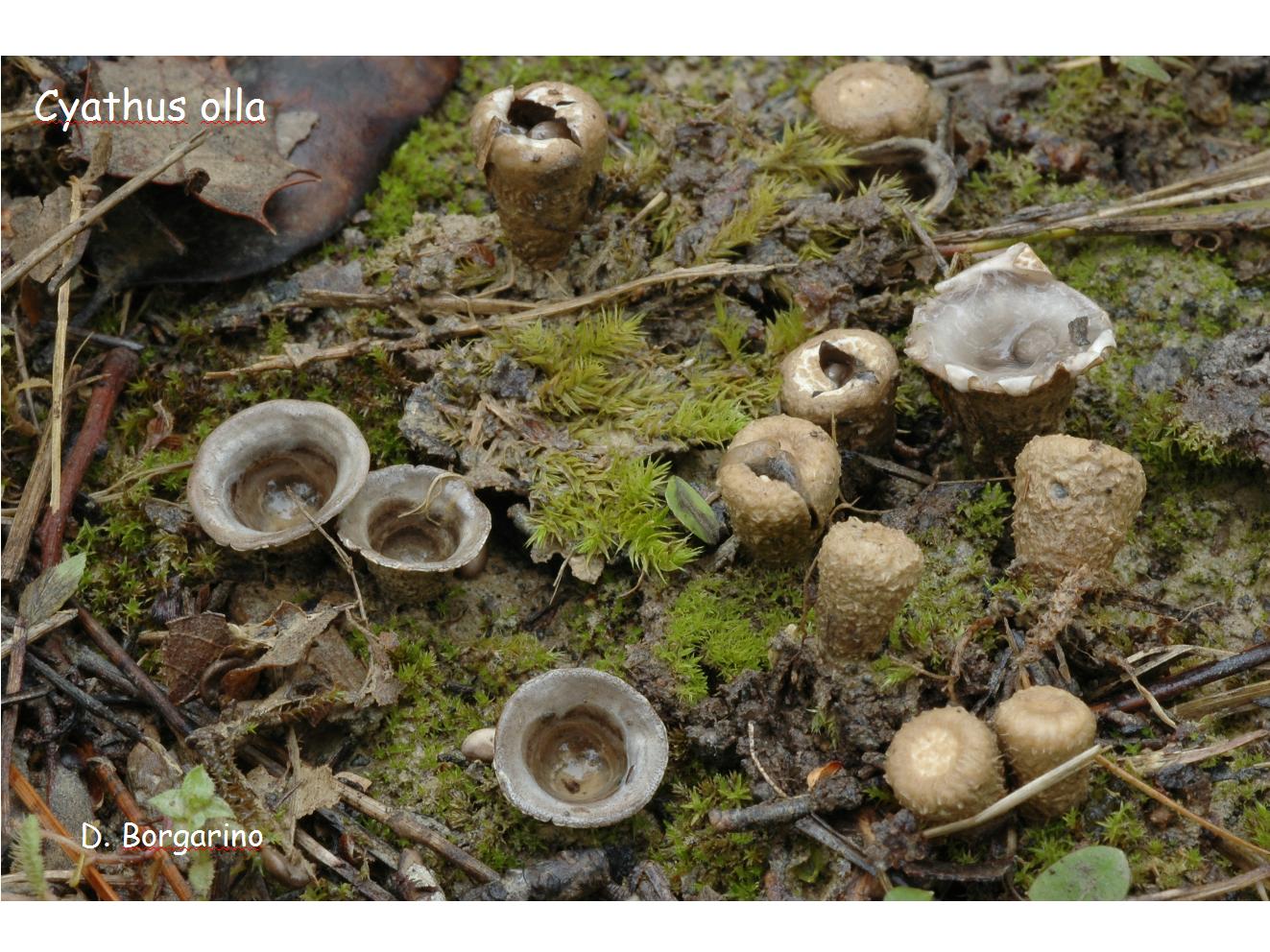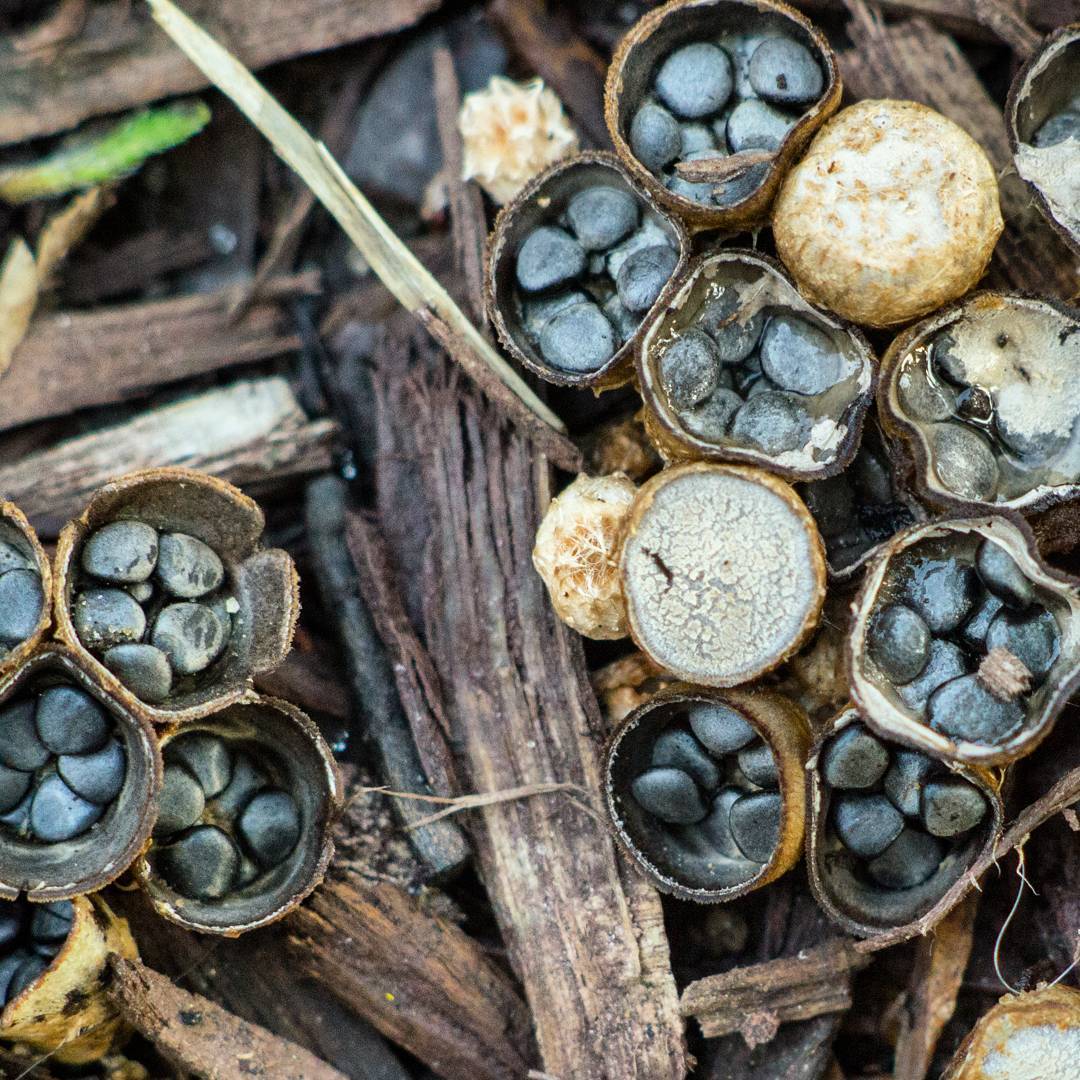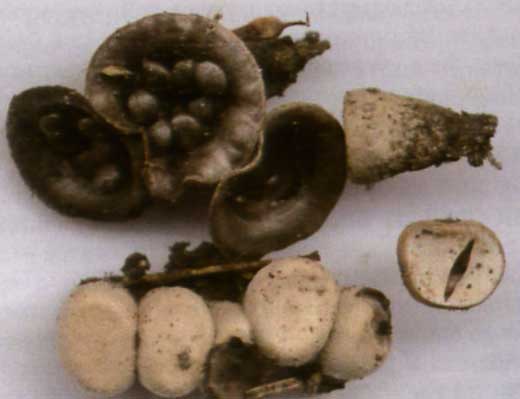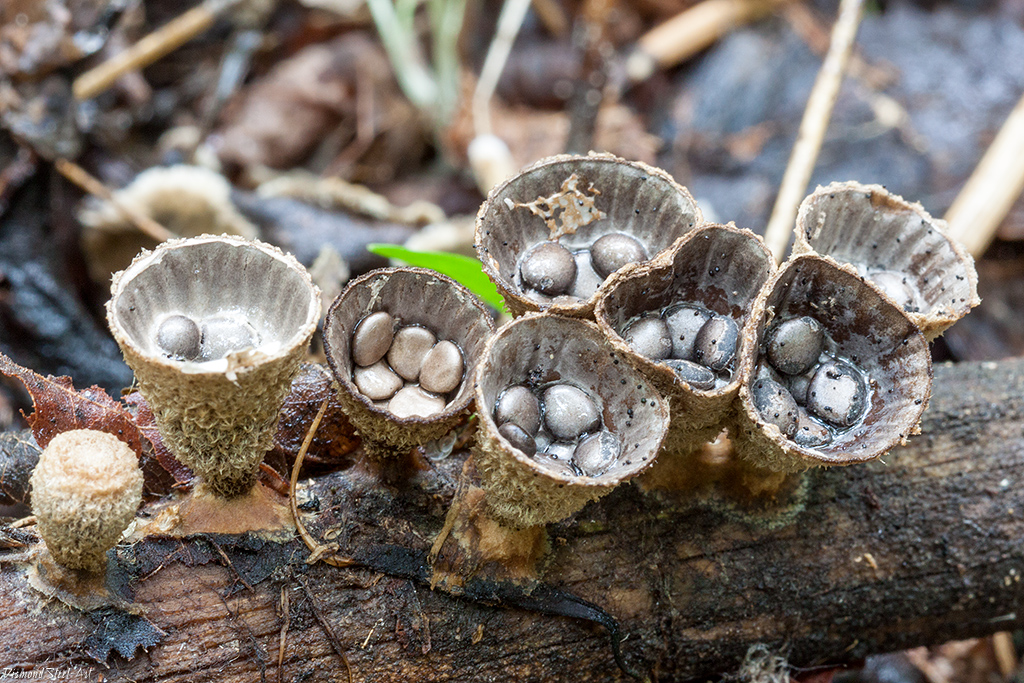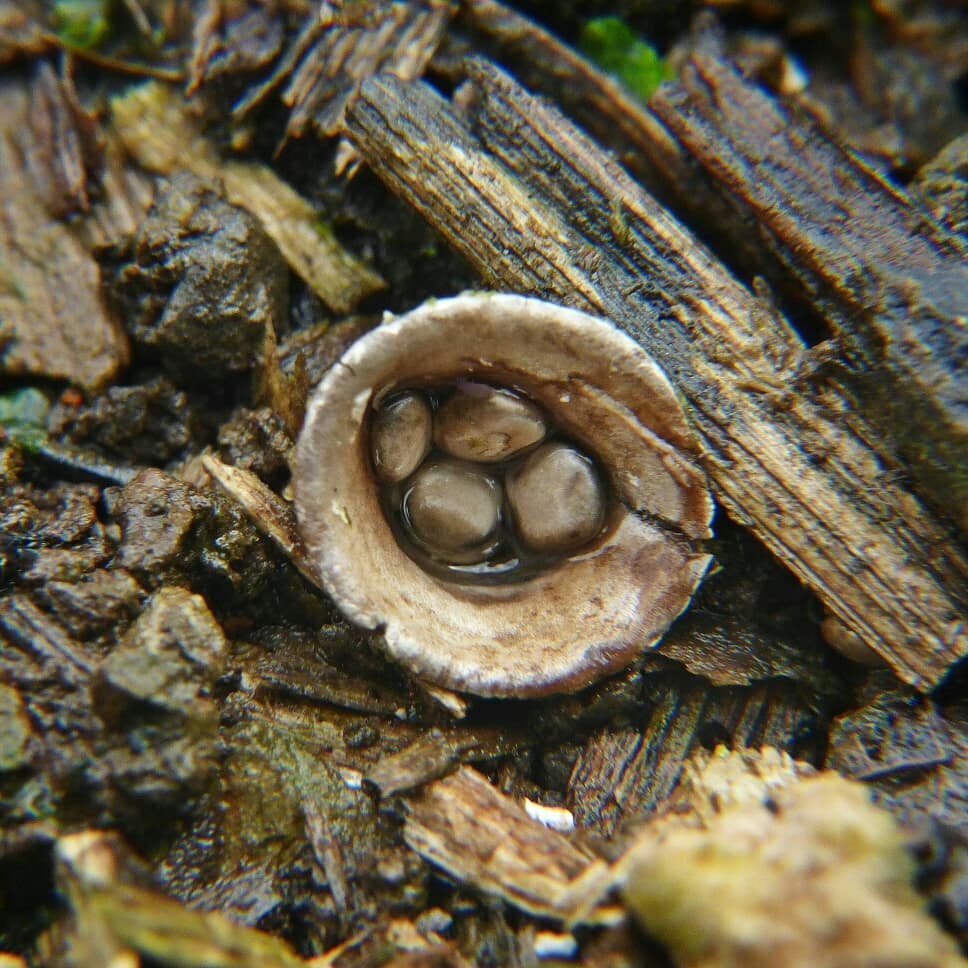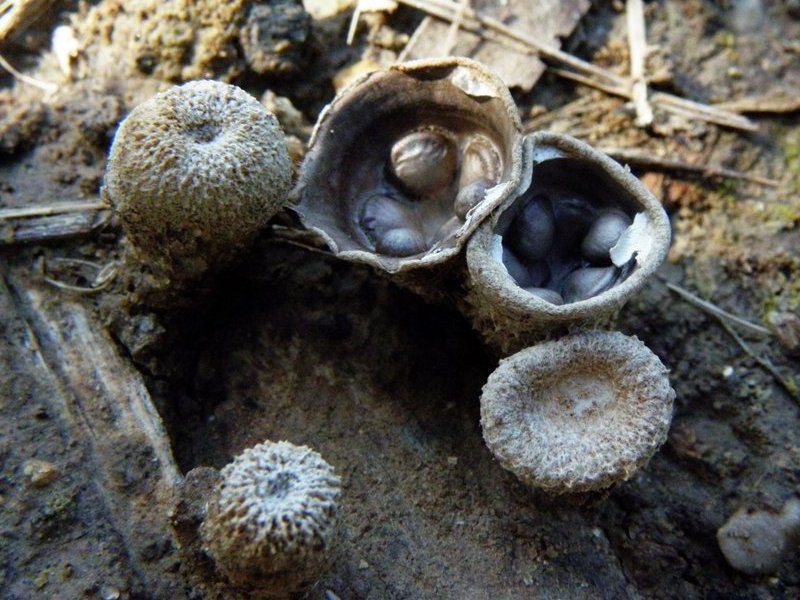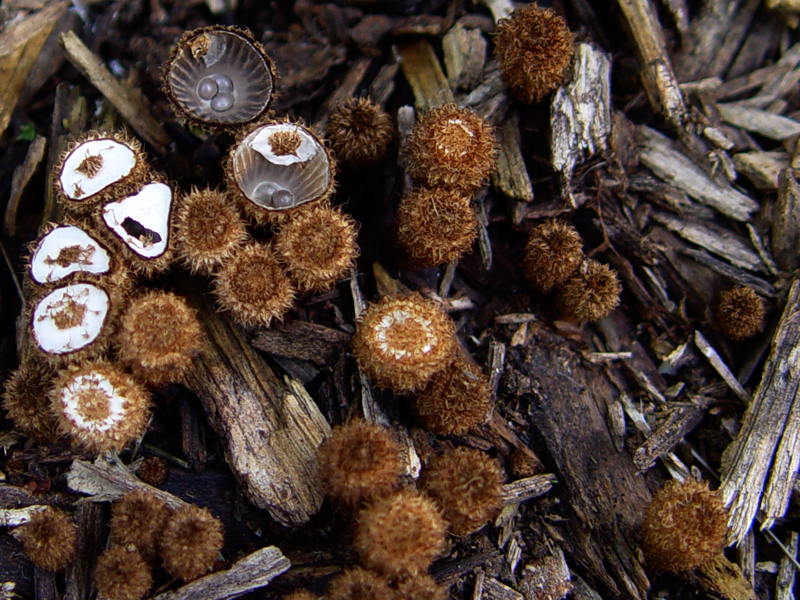Manure glass: photo and description of the mushroom
| Name: | Manure glass |
| Latin name: | Cyathus stercoreus |
| Type of: | Inedible |
| Specifications: |
|
| Systematics: |
|
A dung glass is a miniature inedible mushroom, shaped like a glass or an inverted cone. It is rare, grows in large families on fertile soil. Fruiting in spring and autumn. Since the mushroom has a bizarre shape, it is very difficult to confuse it with edible representatives.
Where does a glass of dung grow
A glass of manure is rare. It prefers to grow on moist fertile soil, on a pile of manure, in decaying deciduous substrate or on dry wood. Bears fruit in large families in spring and autumn. They can also be seen before the beginning of winter after heavy rains.
What does a dung glass look like
Acquaintance with the species must begin with external characteristics. The fruit body in juvenile specimens is oblong, light coffee in color. The surface is covered with a snow-white film that covers the spore layer. As it matures, the membrane ruptures, and gray-gray oblong peridiols appear, which play the role of containers for spores. They are attached to the bottom of the glasses using a mycelial cord.
The species grows in close groups
Outside, the mushroom is covered with microscopic hairs and is painted in ocher or coffee color. The inside is glossy, smooth, gray or black. The pulp is tasteless and odorless, so the mushroom has no nutritional value.
Reproduction occurs in large, thick-walled spores with a glossy surface. As it matures, it breaks apart, and the spores are spread by the wind over long distances.
A glass of manure, like any inhabitant of the forest, has similar twins. Such as:
- Striped is an inedible species that grows in mixed forests. The small fruit body has an oblong shape. As it matures, the top breaks open, exposing the ovoid dark peridioli, and the mushroom takes on the shape of an inverted cone. It is rare, bears fruit in large groups in autumn.
The pulp is tough, tasteless and odorless
The species is widespread in mixed forests
Grows on rotting wood
Is it possible to eat a glass of dung
A dung glass is an inedible representative of the mushroom kingdom. Due to the lack of taste and smell, the species is not used in cooking. But, due to the ability to destroy wood remains, this representative is widely used for processing agricultural residues.
The fungus breaks down lignin without significantly damaging the cellulose. This increases the nutritional value of plant residues and becomes valuable for feeding livestock.
This type of glasses is used in folk medicine. Fruiting bodies secrete antioxidants that protect nuclear DNA. Also, flocks and infusions are made from young specimens for the treatment of gastrointestinal diseases.
Conclusion
A glass of manure - due to the lack of taste, they are not used for food. But the species has found application in agriculture and thanks to its beneficial properties in traditional medicine. It can be recognized by its bizarre shape and roundish black peridioles, which are located inside the cone.
Oll's glass
Oll's Glass - Cyathus olla Pers
Oll's Glass - C. olla Pers.
Fruit bodies are first ovoid, then goblet or bell-shaped, 1.0-1.5 cm in height, 0.8-1.0 cm in width, woody consistency.Peridium outside light ocher, inside lead gray or brown,
smooth, shiny. The epiphragm is white, thin, shiny; when ripe, it breaks off from the edge of the peridium and disappears. The edges of the peridium are slightly bent outward. Peridioli 2-3.5 cm in diameter, lenticular, shiny, gray, dark brown or almost black, with a long white cord.
On decaying wood and various plant debris, on animal excrement, less often on soil. In forests, fields, pastures, vegetable gardens, etc. European part of Russia, North Caucasus, Siberia.
Table 71
Table 71 342 - smooth cruciulum; 343 - Oll's glass; 344 - striped glass; 345 - dung glass; 346 - star spherobolus (stages of development); 347 - cushion nesting.
Encyclopedia of the Nature of Russia. - M .: ABF. L.V. Garibova, I.I. Sidorov. 1999.
See what "Oll's Glass" is in other dictionaries:
Goblet striped - Cyathus striatus Pers see also Genus goblet, cyatus Cyathus Pers. Striped goblet C. striatus Pers. Fruit bodies are spherical or ovate at first, later bell-shaped or elongated funnel-shaped, 0.8–1.6 cm high, 0.6–1 cm wide ... Mushrooms of Russia. Directory
Dung glass - Cyathus stercoreus (Schw.) De Toni see also Genus goblet, cyatus Cyathus Pers. Dung glass C. stercoreus (Schw.) De Toni Young fruiting bodies are ur-shaped, mature reverse conical or bell-shaped, 0.5-1.5 cm tall, 0.4-1 cm in ... ... Mushrooms of Russia. Directory
Genus goblet, cyatus - Cyathus Pers Young fruiting bodies are rounded, mature, broadly goblet-shaped, with jagged edges and a single-layered epiphragm. The peridium is three-layered. Peridioli are lenticular, numerous, dark brown or black, attached to the peridium by a cord. On ... ... Mushrooms of Russia. Directory
GROUP OF ORDERS OF GASTEROMYCETA - A relatively poorly studied group of fungi, numbering about 1000 species from HO genera, grouped into 11 orders of the structural features of fruit chalk. The reference book describes about 50 species of the most common and well-visible ... ... Mushrooms of Russia. Directory
Lignophilic Gasteromycetes - Many species of Gasteromycetes are cosmopolitan. According to their confinement to the substrate, four ecological groups can be distinguished among them. The first clearly delineated group of lignophiles, that is, settling on plant residues: dead wood, ... ... Biological encyclopedia
Crucibulum smooth - Crucibulum laeve (D. С.) Kambly see also Genus crucibulum Crucibulum Tul. Smooth crucibulum C. laeve (D. С.) Kambly The fruit body is spherical at first, then goblet or cylindrical, up to 1 cm tall, yellowish, white towards the base. ... ... Mushrooms of Russia. Directory
Spherobolus star-Shaerobolus stellatus Pers see also Genus spherobolus Shaerobolus Pers. Spherobolus star-shaped S. stellatus Pers. The fruiting body is in the form of a closed cup or spherical, 0.1 to 0.2 cm in diameter. The multi-layered peridium opens up like a star from ... ... Mushrooms of Russia. Directory
Gvezdovka (nidularia) cushion -Nidnlaria pulvinata (Schw.) Fr see also Genus nesting, Nidularia Nidnlaria fr. et Nordh. emend. Tul. Hvezdovka (nidularia) cushion N. pulvinata (Schw.) Fr. Fruit bodies are flattened spherical, often cylindrical, with expanded ... ... Mushrooms of Russia. Directory
Table 71 - 342 smooth crucible; 343 Oll's glass; 344 striped glass; 345 a glass of manure; 346 star spherobolus (stages of development); 347 cushion nesting ... Mushrooms of Russia. Directory
Striped glass
Family: Nesting (Nidulariaceae).
Interesting information. The striped goblet (C. Striatus) is called by the British "a corrugated bird's nest", because it looks a lot like a miniature bird's nest with tiny testicles-peridiols (peridioli are leathery, flattened sacs with spores). Another European name for the striped glass - "splashing cups" - is associated with the way the spores spread: the sides of the fruiting body are tilted inward, which allows falling raindrops to knock out the peridioli with spores from the fruiting body and spray them around.
Description and photo. The striped glass has fruiting bodies 1-2 cm high and about 1 cm in diameter, at first ovoid, rounded, closed, fleecy, brownish-brownish, then become goblet, covered with a whitish felt film. When ripe, the film breaks (remaining partially on the inner walls), and the mushroom becomes goblet.The outer surface of the "goblet" is fleecy, reddish or brownish brown, the inner surface is longitudinally grooved, shiny, grayish, with brownish or grayish, shiny flattened small peridiols (2-3 mm in diameter) lying on the bottom, which fade in dry weather. The striped glass grows in moist deciduous and mixed forests and parks, on rotten branches, deadwood, deciduous stumps, on forest litter, on humus soil, near roads, as a rule, in dense groups, it is not often found throughout the temperate forest zone of Russia. Sometimes a striped glass is found on wood debris, at sawmills and even on rotting wood of various origins (straw
materials mulching sawdust, etc.) within the city. Fruiting from July to October.
Similar species. It is similar to other species of the genus Bokalchik, from which we can clearly distinguish it by the striped inner surface of the fruit chalk.
Pharmacological and medical properties. C. striatus is extremely rich in bioactive components. Back in 1971, it was proved that the fungus produces certain "indole" substances (multicomponent bioorganic molecules with an indole ring), as well as a complex of diterpenoid antibiotics. Together, these complexes are called cyatin. Several years later, studies have shown that indole substances are so-called striatins. Striatins (A, B and C) have a pronounced antifungal activity, and also inhibit gram-positive and gram-negative bacteria. The striped glass also produces sesquiterpenes, called schizandronols. In addition, it contains the triterpenoids glochidon, glochidonol, glochidiol and glochidiol diacetate, cyatinic acid, striatic acid, cyatadonic and epistriatic acids. The last four of the listed components were unknown prior to their isolation from C. striatus.
The mycelium extract and culture fluid of C. striatus showed antibacterial activity against Bacillus cereus and B. subtilis. After isolation of pure striatins (striatins A, B and C), the latter showed antibacterial activity against a large number of species of gram-positive and gram-negative bacteria, as well as activity against imperfect fungi. After the development of a method for the production of striatins by fermentation, these antibiotics were clinically tested against Leishmania amazonensis and Trypanosoma cruzi. These protozoa cause high mortality in tropical regions. Striatin A showed the greatest activity against Leishmania amazonensis after three days of treatment.
NF-kB (nuclear transcription factor "kappabi") is a protein complex involved in the regulation of the immune response to infections. Changes in NF-kB response are implicated in a variety of pathologies, including cancer. For example, it is known that in several types of human cancer, gene NF-kB regulation is usually turned on, disrupting normal gene expression and allowing some cells to survive in such conditions when other cells die. Mushroom extracts prepared from C. striatus show a significant inhibitory effect on NF-kB activation, which provides a good basis for further research in cancer therapy.
Not used in traditional medicine. Currently not going to. Not used for culinary purposes.
Olla's glass photo and description of the mushroom, edibility
Oll's glass: how it looks and where it grows
Olla's glass is an inedible species of the Champignon family. It has an unusual appearance; it grows on woody and deciduous substrates, in the steppes, in forcing, meadows. Fruiting from May to October in large heaped families. Since the mushroom is not eaten, it is necessary to know the external characteristics, view photos and videos.
Where does Oll's glass grow
Olla's glass prefers to grow on a grassy, rotten substrate among deciduous and coniferous trees. The species is distributed in various regions of Russia, bears fruit in large families all summer.It can be found in greenhouses, grows in acceptable conditions in winter.
How does Oll's glass look
Acquaintance with the mushroom must begin with external parameters. The fruit body in young specimens has an oblong or spherical shape; as it grows, it stretches and becomes bell-shaped or takes the form of an inverted cone. This representative has smaller dimensions: the width of the fruiting body can reach 130 mm, height - 150 mm. The velvet surface is covered with a light coffee color. With age, the membrane tissue covering the part on top of the fruiting body breaks through and the inner part of the fungus, lined with peridium, is exposed.
The smooth and glossy peridium is painted dark brown or black. To the inner, wavy part are attached rounded peridiols with a diameter of 0.2 cm, containing ripening spores.
The mushroom distinguishes not a simple shape and color palette
Rounded-angular peridiols have a transverse color, however, they turn white as they dry. To the inner part of the peridium they are fixed with mycelium threads.
The flesh of Oll's glass is absent, the fruit body is thin and tough. Smooth, oblong spores are colorless.
If you look at the mushroom from above, you might think that no more than 3-4 peridoli can be placed in a glass. However, if the fruit body is cut, you will notice that they are arranged in tiers, and there are about 10 of them.
Peridioli are placed in layers
Is it possible to have a glass of Oll
Oll's glass is an inedible representative of the mushroom kingdom. The mushroom is not used in cooking, but it is perfect for making attractive photographs.
Oll's glass, like any forest dweller, has similar doubles. These include:
- Striped - an inedible specimen with an extraordinary appearance. The fruiting body does not have a division into a cap and a stem, it is a velvety ball, which, as it grows, straightens and takes the shape of a glass. The outer surface is covered with a brownish-red paint. The spore layer will cover the entire surface inside and is considered a pantry for maturing spores, which resemble small chestnuts in appearance. A rare specimen, found in deciduous and coniferous forests, picks up decaying foliage and wood as a substrate. Fruits in small groups throughout the warm period.
Dung - refers to the inedible representatives of the forest kingdom. The mushroom is very small in size, resembling a glass or an inverted cone. Prefers to grow on soil with black soil, found on dung heaps. From Oll's glass, the mushroom stands out in size, darker peridiolims, which do not fade when dried. Prefers very high humidity, so it can be found in large families in early spring and late autumn. The enzymes of this forest dweller are used for the manufacture of paper and the disposal of grass and straw. The fruiting body has antioxidants; in alternative medicine, it is used for epigastric pain.
Smooth - inedible, inimitable mushroom, is considered a close person of the champignon. According to external data, there is no similarity, since the fruit body at the smooth glass resembles an inverted cone. Spores are found in peridia, which are located on the upper surface of the fungus. White or brown flesh is tough, firm, tasteless and odorless. In case of mechanical damage, the color does not change, the milky juice is not released. Grows in mixed forests on fallen leaves and decaying wood. Fruiting in countless specimens from June to the first frost.
Conclusion
Oll's glass is an original, inedible representative of the mushroom kingdom. It can be found on rotting substrate and dead wood roots. During the opening of the facial layer, peridiols appear, shaped like chestnuts or coffee beans.
Oll's glass

Oll's glass (Cyathus olla)
Fruit body: in a young mushroom, the fruit body has an ovoid or spherical shape, then as the mushroom matures, the fruit body becomes broadly bell-shaped or conical. The width of the fruiting body is from 0.5 to 1.3 centimeters, the height is 0.5 to 1.5 cm. The edges of the body are bent. At first, the fruit body resembles a wide rounded cone or bell with flexible dense walls slightly tapering towards the base. The surface of the fruiting body is velvety, covered with fine hairs. In young mushrooms, the opening is covered by a cream-colored or beige-brown membranous membrane. As it matures, the membrane collapses and falls off.
Peridium: Outside, the peridium is smooth, dark brown, lead-gray to almost black. On the inside, the sides may be slightly wavy. Attached to the inner shell of the peridium are periodioli, which contain ripening spores.
Periodioli: up to 0.2 centimeters in diameter, angular, whitish when dry, enclosed in a transparent shell. Attached to the inner surface of the peridium with a mycelial cord. Spores: smooth, transparent, elliptical.
Distribution: Oll's goblet is found on grassy and woody remains or on soil in steppes, plantings, forests, meadows and pastures. Fruiting from May to October. It grows in close-knit or scattered groups mainly on rotting wood and the soil around it. Occasionally found in winter. A fairly common species, often found in greenhouses.
Edible: this mushroom is not used for food.
Similarity: resembles the Dung Cup, which is distinguished by a conical narrow body and shaggy-hairy outer surface of the peridium, black periodioli, larger spores and a darker inner surface of the fruiting body.
Note: The young fruit bodies of the Oll Goblet resemble a ball or nest in shape. Then the fruiting bodies acquire a goblet or bell-shaped shape. A distinctive feature of the fungus is the presence of a single-layer membranous membrane that hides the opening and the serrated edge. Periodioli - lenticular rounded parts of the gleb, which are attached to the shell with a mycelial cord, ripen inside the hole. In a mature mushroom, the membrane ruptures and falls off.


